Graphics cards compared: 10 rated
1. Asus GeForce GTX 590
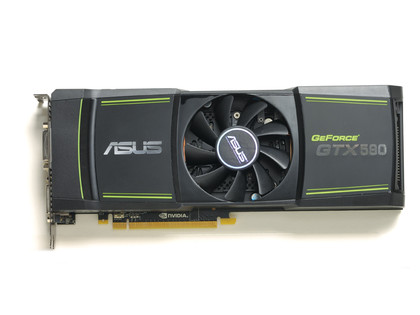
So here it is, the pinnacle of Nvidia engineering and the fastest single-PCB graphics card the Santa Clara company has ever produced. It's quite spectacular – we're talking about one board with two of the most powerful GPUs Nvidia's ever made jammed on it.
Obviously, compromises have had to be made with the chips to get them to run happily on a single card, and to stay within the 375W limit that comes from a pair of 8-pin PCI-e connectors and the motherboard PCI-e bus.
Read the full Asus GeForce GTX 590 review
2. Asus Radeon HD 6990
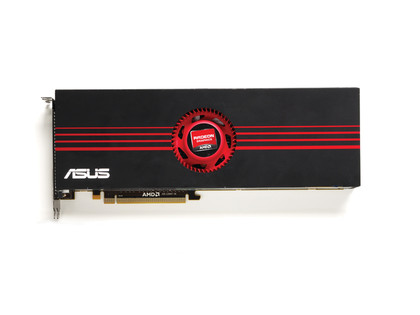
Pipping Nvidia to the post came AMD, releasing its dual-GPU, top-end graphics card a few weeks earlier than the competition. As with Nvidia, the HD 6990 is the fastest single-PCB graphics card the Texan brand has ever made, with performance to match.
It almost looks as though both cards have come from the same design school, with so many similarities between them it borders on the suspicious. Like the GTX 590, the HD 6990 houses two of the cores from its current-fastest single- GPU card – the HD 6970.
Sign up for breaking news, reviews, opinion, top tech deals, and more.
The Cayman XT from that card has been doubled up and redubbed 'Antilles', and comes with slower clock, shader and memory speeds out of the box.
Read the full Asus Radeon HD 6990 review
3 Zotac GeForce GTX 580
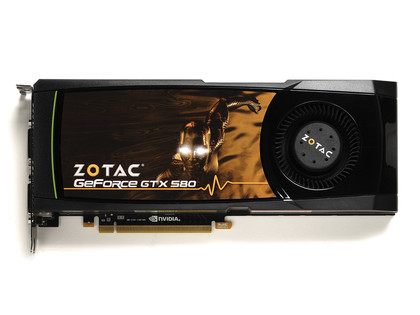
Nvidia's GTX 580 is the best single-GPU card on the market. There's no caveat – across our entire benchmarking suite, it held sway over all others. It's down to the exemplary GF110 GPU sitting at the heart of it.
Fermi has proven to be the best GPU architecture the green company has ever manufactured, and with this second generation, the GTX 5xx series, it's gone from strength to strength.
The first Fermi, the GTX 480, was the top card of its day, but wasn't without issues. The problem was the amount of power it needed and the quantity of heat it generated.
Read the full Zotac GeForce GTX 580 review
4. HIS Radeon HD 6970
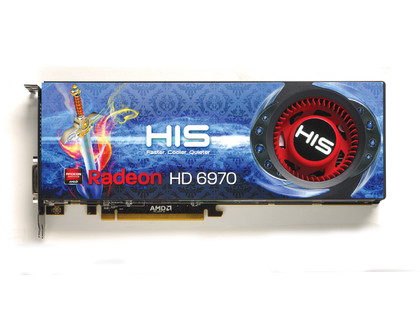
The fastest single-GPU model out of the AMD stable is a tough one to recommend. As the first of its Northern Island codenamed graphics cards, it's certainly the quickest AMD has come out with.
The big problem, though, is the second-tier card released alongside it – the HD 6950. But we'll come to that later.
The Cayman XT at the heart of the HD 6970 is essentially the same GPU as paired in the Antilles chip of the dual-GPU HD 6990. It's clocked faster than the stock specs of the Antilles, though – through the shaky-ground magic of the Antilles Unlocking Switch (also known as the Screw Your Warranty Switch) the HD 6990 can run with its GPUs at the same speed as the HD 6970.
Read the full HIS Radeon HD 6970 review
5. Zotac GeForce GTX 570
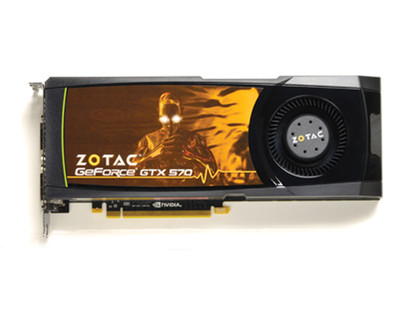
The GTX 570 represents the second tier of Nvidia's Fermi architecture lineup. Coming in a little cheaper than AMD's top single card, the HD 6970, it's an impressive beast. As much as the GTX 580 was the GTX 480 engineered properly, the GTX 570 is a lot more than just the GTX 470 done right.
It has more in common with the GTX 480, coming as it does with almost the same basic GPU layout. The GTX 570 has the same 480 CUDA cores and 60 texture units, but drops eight ROPs compared with the GTX 480's 48. The 570 also has a smaller frame buffer, at 1,280MB against the previous generation card's 1,536MB.
Read the full Zotac GeForce GTX 570 review
6. Sapphire Radeon HD 6950
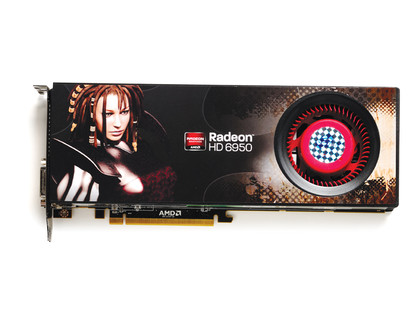
We understand that, in pure performance terms, the HD 6990 and HD 6970 have the HD 6950 beaten. But in our eyes, this is the finest graphics card AMD has produced in a long time. In the sub-£200 market, it's as good as you're going to get, and it's a card that offers much more than any of the opposition.
In its plain state, the HD 6950 comes close to the HD 6970 performance-wise, and to the GTX 570 too. The 2GB GDDR5 frame buffer means it can keep pace with Nvidia's second-tier Fermi card, although for the most part it does lag behind slightly. It does the same with the HD 6970, but that's to be expected from a card that's much, much cheaper.
Read the full Sapphire Radeon HD 6950 review
7. MSI GeForce GTX 560 Ti
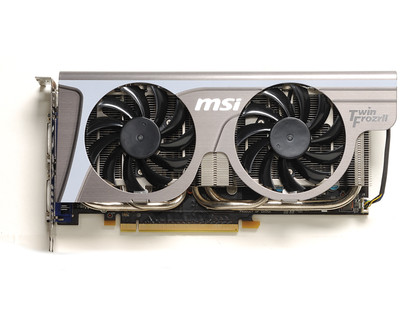
Just as the GTX 570 was replacing the GTX 480, leaving the GTX 580 out on its own at the head of the single-GPU pack, here we've got the GTX 560 Ti retiring the GTX 470, not the GTX 460.
Yes, that's a lot of numbers, but it does make sense, especially when you look at the performance of those GTX 460s, even in today's market. It would make no sense for Nvidia to kill off one of the best cards it's launched since the halcyon days of the 8800 GT.
But it's not quite as simple as just being another transistor-level tweak of the GTX 470 design. The GTX 560 Ti is more of a halfway house between the GTX 470 and GTX 460.
Read the full MSI GeForce GTX 560 Ti review
8. XFX Radeon HD 6870
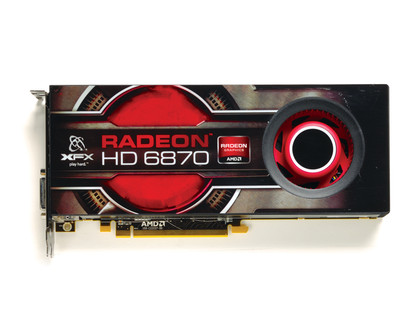
Once you drop below the price point of the competing HD 6950 and GTX 560 Ti, you get into the value segment. That's not value as in 'value' toilet paper – it's all about the price, and not necessarily the performance.
With the HD 6870, you'd only be looking at this card if you really couldn't afford to spend a pound more than its listed price. That's not to say it's a bad card. It compares favourably with the marginally more expensive GTX 560 Ti, though when we first saw it at launch, the combination of relatively high price point (£200 at release) and older technology meant it got a fairly poor reception.
Read the full XFX Radeon HD 6870 Ti review
9. EVGA GTX 460 1GB
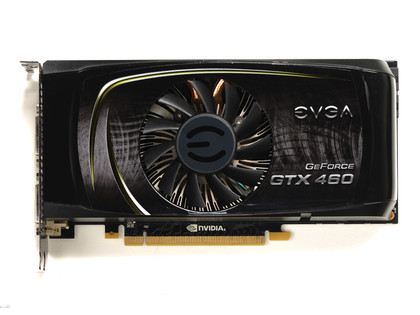
Over the last 12 months, if there's been one card you could call the a hero, it's most definitely the GTX 460 1GB. Nvidia has had a long history of creating superb mid-range cards, from the 6600 GT to the incredible 8800 GT, and the GTX 460 can sit happily among such illustrious forebears.
Based on the same Fermi architecture as the hot-and-heavy GTX 480, the GTX 460 carries the torch into the lower end of the price spectrum. At launch it was priced at £200, the same as the GTX 560 Ti when it was first released. However, thanks to the passage of time, you can now pick up an overclocked 1GB version for as little as £120.
Read the full EVGA GTX 460 1GB review
10. Sapphire Radeon HD 6850

Thanks to the shift in pricing that followed the the AMD HD 68xx series, the HD 6850 has come into its own more in the intervening months. Now available for as little as £132, it's about the same price as the GTX 460, and just about had it pipped to the post in most of our benchmarking suite.
Like the HD 6870 before it, it's based on the same Barts GPU, a reworking of the GPU at the heart of AMD's last generation of DirectX 11 graphics cards, the HD 58xx series. In real terms, though, this card was brought in to replace the excellent HD 5770, despite what the naming structure may have you believe.
Read the full Sapphire Radeon HD 6850 review
Bench analysis: Making sense of an awful lot of numbers
Because of the awesome amount of graphical power at our fingertips, with this latest batch of DirectX 11 cards all of the benchmarks below represent their performance at the very highest single-screen resolution possible; 2,560x1,600.
With the really intensive DirectX 11 benchmarks you can see a clear divide between the top contenders for the top GPU crown and the alsorans. Heaven 2.5 though shows a nice, smooth gradient as you move down the power order, but you can see with the incredibly demanding Metro 2033 that there is a definite step where the cards simply cannot provide enough graphical grunt to run the game at such high resolutions.
Even the GTX 570 fails to get into double figures in SLI. It's here the HD 6950 shows its muscles, keeping pace with the GTX 580 in this most demanding of benchmarks.
The multi-GPU performance is interesting too, with only the synthetic Heaven 2.5 test showing consistent GPU scaling with up to four GPUs. And talking of multi-GPU the power of twin budget cards, like the GTX 460 and HD 6850, proves a match for single, pricier options.
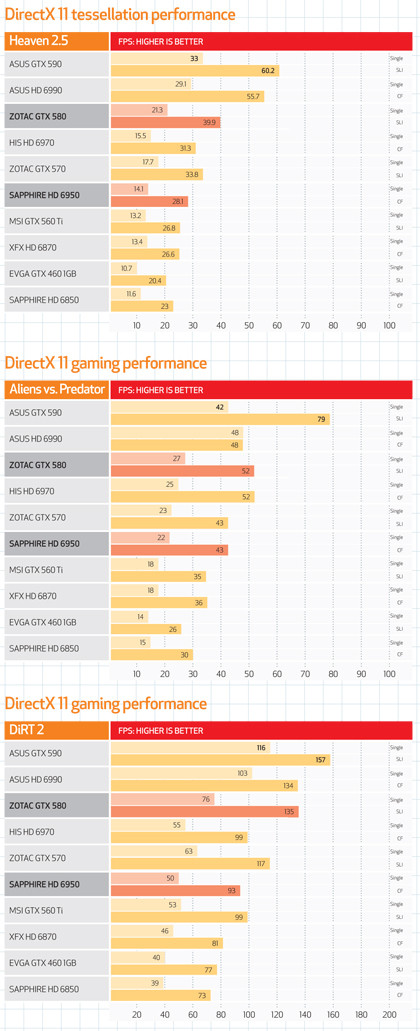
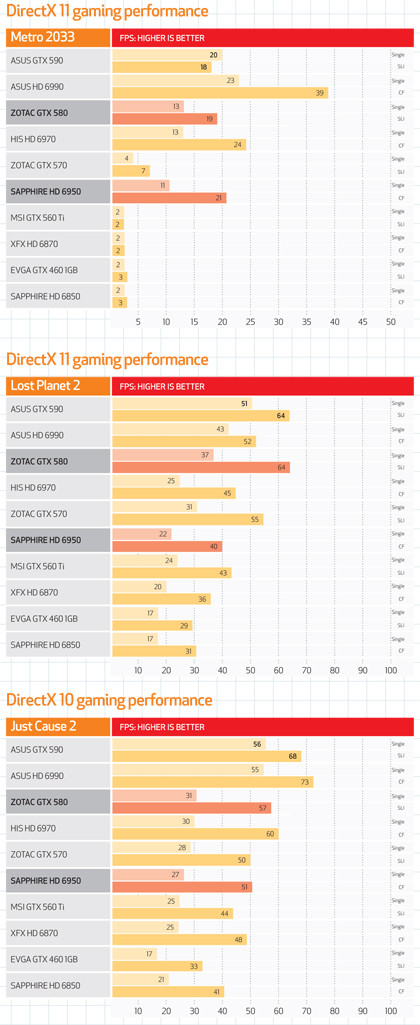
And the winners are...
Nvidia GeForce GTX 580 AMD Radeon HD 6950

With so much choice in the graphics card arena it can be tough to make a definitive call on what the best cards are for what purposes. There are some standout performers in the test and some weaker options which you can almost discount immediately.
At the top end though things are incredibly tight. In terms of pure, out of the box performance you'd have to side with the GTX 590 as the three-screen hero single card. But with the frankly obscene performance of the GTX 580 in SLI, and despite the price-tag, we'd have to go for the separate, faster cards in SLI over the single-PCB, multi-GPU GTX 590.
AMD's HD 6990 comes in behind them, though with the ability to power up to five screens through its EyeFinity tech. With the, admittedly warranty-voiding, Antilles Unlocking Switch making overclocking the card as easy as flicking a switch (and hoping your PSU doesn't fall over) the HD 6990 actually does have a lot going for it.
Neither multi-GPU card though looks good in quad-GPU trim. Neither camp's drivers are really up to snuff, with only the Heaven 2.5 benchmark actually scaling properly. And driver problems, even with two GPUs, can mean a wait, post game release, for your cards to be supported.
Which makes a single GTX 580 a fantastic proposition on its own, it's fast, though does lack proper multi-monitor support. So Nvidia's top card becomes a double winner in single and SLI flavours.

AMD's top single-GPU card, the HD 6970, while being a decent card in of itself, is actually hampered by its own brethren. The HD 6950, in its default, vanilla flavour is almost as fast as the top AMD single-GPU card and for almost £100 less. Combined with the outstanding performance of the GTX 570 makes the 6970 impossible to recommend.
In the mid-range there really is only one winner, and that's the HD 6950. On its own it's a great performing card, keeping pace with both the HD 6970 and the GTX 570. If you factor in the unlocking potential and subsequent overclocking chops that turns it into a monster of a card for under £200.
You can also pick up two of them for the same price as a single GTX 580 and give Nvidia's top GPU a darned good thrashing while you're at it.
So if you're looking at a single, high-resolution monitor then Nvidia's GTX 580 will come without any driver hassle and keep your games looking great. For a serious multi-screen setup it has to be an AMD card, and personally I'd opt for a pair of unlocked HD 6950s, though the HD 6990, PSU-willing, will deliver incredible performance.
----------------------------------------------------------------------------------------------------
First published in PC Format Issue 253
Liked this? Then check out 15 best graphics cards in the world today
Sign up for TechRadar's free Week in Tech newsletter
Get the best tech stories of the week, plus the most popular news and reviews delivered straight to your inbox. Sign up at http://www.techradar.com/register
- 1
- 2
Current page: 10 top gaming graphics cards compared
Prev Page Graphics cards compared: what to look for